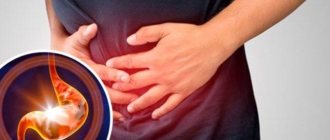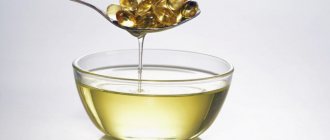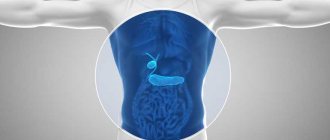Gastritis of the stomach: symptoms, treatment regimen and nutritional rules
Gastritis is a common disease that involves inflammation of the gastric mucosa due to the influence of factors of various origins, gradually leading to dystrophic changes in the epithelium.
Morphological changes that progress over time cause disruption of the functioning of the organ, which affects the patient’s well-being and worsens his quality of life.
Depending on the degree of damage and the duration of exposure to irritating factors, acute and chronic forms are distinguished.
Reasons for development
Symptoms of the disease occur when the gastric mucosa is damaged. Various factors influence:
- irregular eating, undereating and overeating, rushing while eating;
- poor chewing of food, often associated with poor dental health;
- low-quality products, abuse of fried, hot, spicy, rough foods;
- insufficient intake of protein and vitamins, which causes less gastric juice to be produced;
- regular drinking, smoking;
- long-term use of medications: antibiotics, aspirin, hormonal drugs;
- ill health of the digestive system, impaired peristalsis, causing bile to end up in the stomach and cause inflammation of the mucous membrane;
- signs of gastritis appear in case of imbalance of intestinal microflora, penetration of viruses, bacteria, streptococci, staphylococci, salmonella.
Chronic gastritis in adults occurs with poor quality or incomplete treatment of the acute form. Intestinal infections, inflammation of the tonsils or gallbladder, infection with Helicobacter pylori maintain the chronic form. It develops in hazardous production conditions, when dust, fumes of acids or alkalis, and harmful chemical compounds are ingested every day. Constant inflammation of the gastric mucosa is associated with one or another allergy.
The gastric juice contains pepsin to break down protein foods. If a malfunction occurs, pepsin acts on the mucous membrane containing protein, causing inflammation as the stomach begins to digest itself.
Epidemiology
According to statistics, gastritis is registered in 80-90% of adults. Helicobacter pylori associated is recognized as the most common; it accounts for 90% of all diagnoses of chronic hepatitis. The most dangerous form with a high percentage of malignancy is atrophic, occurring in 5% of cases in people under 30 years of age, in 35% in patients 30-50 years of age, in 70% in patients over 50 years of age.
In children, the disease most often develops during puberty and at the age of 4-7 years, when the child is most susceptible to infectious and viral diseases.
The role of Helicobacter pylori in the development of gastritis
In the second half of the 20th century, a previously unknown factor was identified, which today is considered one of the first places in the etiology of chronic gastritis. Helicobacter pylori is a spiral-shaped gram-negative bacterium that infects various areas of the stomach and duodenum.
Many cases of gastric and duodenal ulcers, gastritis, duodenitis, and possibly some cases of gastric lymphoma and gastric cancer are etiologically associated with Helicobacter pylori infection. The successful experience with self-infection of one of the discoverers of the role of Helicobacter pylori in the development of diseases of the stomach and duodenum, Barry Marshall, and a group of volunteers served as convincing evidence of this theory. In 2005, Barry Marshall and his colleague Robin Warren were awarded the Nobel Prize in Medicine for their discovery.
However, the majority (up to 90%) of infected Helicobacter pylori carriers do not show any symptoms of disease. Not every chronic gastritis has a bacterial cause.
Causes
It is quite difficult to name the exact cause of gastritis. However, doctors still identify several factors that provoke the appearance and further development of this unpleasant disease:
- passive lifestyle;
- improper and irregular nutrition;
- bad habits;
- taking dangerous drugs;
- constant stress.
pixabay.com/carlosfs05
Classification
There are several types of acute gastritis:
| Simple (catarrhal) gastritis | develops as a result of ingestion of stale food contaminated with pathogenic microbes (foodborne toxic infection), with rotavirosis, an allergy to some food product, or as a result of damage to the gastric mucosa by certain medications. With catarrhal gastritis, the mucous membrane is destroyed slightly (only the most superficial layer) and is quickly restored after the irritating factor ceases. |
| Erosive gastritis | develops after some concentrated acids or alkalis enter the stomach (chemical burn of the gastric mucosa). With corrosive gastritis, not only the superficial, but also the deep layers of the gastric mucosa are destroyed, so this form of the disease often gives rise to peptic ulcers or scar formation. |
| Phlegmonous gastritis | This is a purulent inflammation of the stomach, which can develop as a result of a foreign object (for example, a fish bone) entering the stomach wall, followed by infection of this area with a pyogenic infection. A distinctive feature of this type of gastritis is high fever and unbearable pain in the epigastric region. Phlegmonous gastritis requires immediate surgical intervention. Without medical assistance, the disease progresses to peritonitis (extensive inflammation of the abdominal organs) and ends in death. |
| Fibrinous gastritis | occurs very rarely against the background of sepsis (blood poisoning). |
Gastritis has many varieties. A brief description of each type can be found below:
| Low acidity | insufficient concentration of acid in gastric secretions, which creates conditions for weak fermentation of incoming food. As a result, the walls of the stomach can be damaged by rough pieces of food, and the body does not receive the required amount of substances. |
| With high acidity | increased concentration of gastric juice, forming persistent, sometimes causeless heartburn. The atypical saturation of the enzyme fluid stimulates the formation of multiple ulcerations on the mucosa. |
| Atrophic | gradually leads to thinning of the epithelium of the stomach, degeneration of the glands into simpler forms and a decrease in the quality of the work they perform. Without corrective therapy, it can cause cancer. |
| Antral | develops against the background of infection by Helicobacter pylori culture, leading to focal modifications of the internal epithelium. The result of bacterial activity is scarring of the mucous membrane and insufficient formation of gastric secretions. |
In professional medicine, other classifications of gastritis are also used, including according to the type of distribution of pathogenesis:
- Autoimmune gastritis (type A);
- Exogenous gastritis (type B), provoked by Helicobacter pylori;
- Mixed gastritis (type A+B);
- Gastritis (type C), provoked by NSAIDs, chemical irritants or bile;
- Special forms of gastritis;
- Gastritis against the background of decreased and increased secretion of hydrochloric acid;
- Other forms of morphological and functional manifestations of gastritis.
Their differentiation involves the use of complex medical laboratory or instrumental techniques at the stage of diagnosing the disease. Therefore, a description of gastritis, which has approximately the same clinical symptoms, but differs in the underlying mechanisms of pathogenesis, is not of interest to a wide range of readers.
Let us dwell in detail on the main signs and symptoms of gastritis, which may serve as the basis for a person to contact a medical institution for help.
Stages of gastritis
- Hyperemia. At the first stage of gastritis development, hyperemia (redness) of the gastric mucosa is observed. This is a protective vegetative-vascular reaction - dilation of blood vessels and increased blood flow in response to a negative effect on the mucous membrane. Hyperemia is accompanied by edema, this is a sign of the development of inflammation.
- Chronic inflammation, metaplasia, dysplasia. The production of hydrochloric acid decreases, the mucous membrane thickens. Hypertrophy is typical for people who abuse alcohol. Inflammation is characterized by the accumulation of leukocytes in the stomach wall; prolonged inflammation can change the structure of the gastric epithelium, it can become similar to intestinal epithelium, this phenomenon is called metaplasia and may be associated with an increased risk of cancer. But the risk is especially high if a biopsy reveals a violation of the structure of the tissue and cells of the stomach - dysplasia.
- Atrophy. Prolonged inflammation causes thinning of the gastric mucosa, recovery processes slow down, atrophic changes in the mucosa are observed - epithelial cells die and are replaced by scar tissue.
- Erosion and ulcers are a frequent companion to gastritis. Focal and profound changes develop due to a decrease in the performance of the mucous glands, thinning of the protective layer, in most cases this is a consequence of exposure to H. pylori.
Symptoms of gastritis in adults
The characteristic symptoms of gastritis in adults depend on the form of the disease. Acute gastritis is characterized by the following symptoms:
- nausea is constant or intermittent, often occurring immediately after eating;
- abdominal pain: sharp paroxysmal or constant painful. Often depends on food intake: worsens on an empty stomach or some time after eating;
- repeated vomiting, first of stomach contents with a sour smell and taste, then of clear mucus, sometimes greenish or yellow and bitter in taste (bile);
- heartburn - an unpleasant burning sensation in the chest that occurs after eating;
- belching with a sour smell, after eating or on an empty stomach;
- bowel dysfunction: constipation or diarrhea;
- increased salivation is the body’s reaction to indigestion; sometimes dry mouth (after several bouts of vomiting due to dehydration)
- from the whole body: severe general weakness, dizziness, headache, sweating, increased temperature, decreased blood pressure, increased heart rate - tachycardia.
High and low acidity
The most common signs of gastritis with low or zero acidity:
- constant unpleasant taste in the mouth;
- heaviness in the stomach after eating;
- burping “rotten eggs”;
- rumbling;
- nausea in the morning;
- problems with regularity of bowel movements;
- disgusting breath.
The most common signs of gastritis with high acidity, in addition to general symptoms (vomiting, nausea):
- prolonged pain in the solar plexus, disappearing after eating;
- frequent diarrhea;
- heartburn after eating sour foods;
- frequent urge to pass gas from the mouth - belching.
Signs of exacerbation
Relapse of chronic gastritis is characterized by a variety of symptoms, the most common are the following symptoms:
- Increased salivation, thirst, weakness;
- Manifestations of dyspepsia (constipation, diarrhea);
- Dizziness, palpitations, headache;
- Nausea, morning vomiting of semi-digested food with a characteristic sour taste, sometimes vomiting bile;
- Constant or periodic pain in the solar plexus, which intensifies immediately after eating, or vice versa, with prolonged fasting;
- Belching with air, burning in the sternum, heartburn after eating, metallic taste in the mouth.
Symptoms of exacerbation of erosive (severe) forms of gastritis are supplemented by vomiting with blood clots, sometimes vomiting with dark-colored vomit. Gastric bleeding during bowel movements is manifested by black stool. Sometimes gastric bleeding can only be determined by laboratory methods. Massive internal bleeding is manifested by pallor of the skin and mucous membranes and is easily determined by the color of the sclera of the eyes, dizziness, and tinnitus.
Complications
Gastritis in adults (with the exception of phlegmonous gastritis) does not belong to the group of dangerous diseases. However, gastritis gives rise to dangerous complications:
- Stomach bleeding
- Peptic ulcer of the stomach and duodenum,
- Stomach cancer.
The effect of gastritis on the body as a whole is explained by a disorder of the digestive process. Patients with gastritis begin to “fear food”, lose weight, some vomit most of the food they eat, or suffer from heartburn after eating. Against the background of gastritis, vitamin deficiency and anemia often develop.
What complications are there?
A prolonged increase in the concentration of hydrochloric acid in the stomach can lead to the following complications:
- development of an ulcer – a defect in the stomach wall in the form of a non-healing wound;
- duodenitis - inflammation of the duodenum as a result of hydrochloric acid entering it;
- the transition of gastritis to a tumor disease - constant irritation of the gastric mucosa with hydrochloric acid can provoke its uncontrolled growth and the appearance of a tumor.
Diagnostics
Stages of diagnosing chronic gastritis:
- Endoscopic diagnosis with mandatory biopsy - the presence of Helicobacter pylori, the nature and localization of changes in the gastric mucosa, the presence of precancerous changes in the gastric mucosa are clarified. For a biopsy, at least 5 fragments are taken (2 from the antrum, 2 from the body of the stomach, 1 from the angle of the stomach).
- Clinical diagnosis - the patient’s complaints, anamnesis, examination data of the patient are analyzed, a presumptive diagnosis is made and a rational plan for instrumental examination is drawn up.
- Laboratory diagnostics - clinical blood test, biochemical blood test, clinical urine test, clinical stool test, stool occult blood test, detection of Helicobacter pylori infection.
- Respiratory diagnostics - the presence of Helicobacter pylori is specified. This method involves the patient taking urea of normal isotopic composition and then measuring the ammonia concentration using a gas analyzer.
- Intragastric pH-metry - determination of the state of secretion and diagnosis of functional disorders in acid-related gastrointestinal diseases.
- Ultrasound examination of the liver, pancreas, gall bladder - to identify concomitant diseases of the gastrointestinal tract.
- Manometry of the upper gastrointestinal tract, with the help of which the presence or absence of reflux gastritis is determined (normally in the duodenum the pressure is 80-130 mm water column, in patients with reflux gastritis it is increased to 200-240 mm water column .).
- Electrogastroenterography is a study of the motor-evacuation function of the gastrointestinal tract in order to determine duodenogastric reflux.
Establishing a clinical diagnosis is based on determining the type of chronic gastritis, assessing the prevalence of morphological signs of the disease, the presence and severity of gastric dysfunction.
Etiology
The development of gastritis is caused by the influence of many factors on gastric tissue. Among the reasons, exogenous and endogenous factors are distinguished.
Exogenous factors include:
- eating disorders;
- bacterial colonization by Helicobacter pylori, less commonly by other bacteria or fungi;
- radiation exposure, chemical damage;
- long-term use of medications that irritate the mucous membrane (the most aggressive are glucocorticosteroids, anti-inflammatory drugs, acetylsalicylic acid, etc.);
- parasitic infestations;
- bad habits (especially alcohol and smoking);
- chronic stress.
Among the endogenous factors are:
- genetic predisposition;
- autoimmune processes;
- duodenogastric reflux;
- metabolic disorders;
- endogenous intoxications;
- endocrine dysfunctions;
- hypoxemia;
- avitaminosis;
- chronic infectious diseases;
Also, the development of gastritis is promoted by various reflex effects from other affected organs.
Treatment of chronic gastritis
In 90% of cases, chronic gastritis in adults is caused by the bacterium Helicobacter pylori. Therefore, with this disease, the first step is to examine the patient for the presence of this pathogen in the body. Also equally important is the analysis of gastric juice, which will help choose the optimal treatment.
The main stages of treatment of chronic gastritis in adults are as follows:
- Anti-Helicobacter therapy is carried out. It is performed for 10 days according to a 3-component scheme: hydrogen pump blocker, amoxicillin, clarithromycin. If it was not possible to achieve an effect, then after a month and a half the treatment is repeated according to a 4-component scheme. At the same time, de-nol is added to these agents.
- An appropriate diet is selected.
- Low acidity requires enzyme replacement therapy. For this purpose, multienzyme drugs are prescribed - enzistal, festal, mezim, abomin.
- If acidity is high, medications are used to reduce it. This reduces pain and heartburn and speeds up the healing process.
- The use of traditional medicine is permitted in combination with medications.
Modern approaches to the treatment of chronic gastritis have reduced the prevalence of this disease and significantly reduced the frequency of exacerbations. But despite this, Helicobacter infection can easily recur. Therefore, for those who want to forget about the disease for a long time, it is necessary to take care of eliminating predisposing factors.
Herbs
Herbal treatment of acute gastritis is very effective. It is very important to follow the dosage when preparing infusions and decoctions and to complete the course of treatment.
Plantain for gastritis
Plantain is an unpretentious plant that can grow everywhere. An infusion based on plantain will help cope with the symptoms of gastritis. To prepare the medicine, you will need to grind the leaves of the plant (50 g) and pour in 400 ml of boiling water. After 120 minutes, you can strain the tincture and drink 25 ml every 2 hours. The duration of therapy is 90 days.
Read also: Diseases of the esophagus
Chamomile
Medicinal chamomile effectively relieves inflammation and calms the nervous system. By drinking chamomile tea you can quickly relieve tension, overcome insomnia and restore the normal functioning of the digestive system. Chamomile drink is often used in the treatment of gastritis. You should drink the healing liquid instead of tea throughout the day.
The course of treatment lasts 90 days. To enhance the taste and aroma of tea, you can add two tbsp. l. milk or honey. With the help of chamomile you can quickly cope with gastritis. If dried flowers are used to prepare the tincture, the liquid turns out strong and it is best to drink it 1 tbsp. l. for the night. Chamomile infusion can be prepared with the addition of St. John's wort, yarrow and mint.
Medicinal chamomile effectively relieves inflammation and helps cope with stress
Celandine
Celandine is actively used in folk medicine for the treatment of various ailments. With the help of celandine juice, you can cauterize inflammation on the skin. The plant also helps cope with chronic gastritis.
Important! Treatment with celandine should be prescribed by the attending physician. The herb is a poisonous plant, so the advisability of its use can only be determined by a specialist. Treatment begins with taking a small dosage of tincture. Every day the amount of liquid you drink may increase.
Preparation:
- Mix celandine (50 g) with a spoon of honey.
- After thoroughly mixing the composition, take it throughout the day before each meal, 1 tbsp. l.
- The infusion is stored in a cool, dark place for no more than 5 days.
Calendula
The inflorescence of calendula contains various acids in its composition, namely salicylic, ascorbic, malic. Also in the composition of calendula you can find phytoncides, calcium and saponins. Calendula has a beneficial effect on the body, providing the following effects:
- sedative,
- bactericidal,
- antitoxic,
- diuretic,
- anti-inflammatory,
- antispasmodic.
The plant effectively helps cope with erosive gastritis. For cooking you will need 3 tbsp. l. calendula flowers. Having placed the inflorescences in an enamel container, fill them with 600 ml of boiling water. Let it sit for 2 hours. After straining, we drink 100 ml at a time throughout the day. To enhance the effect, you can add mint and chamomile to the calendula. The course of treatment lasts 40–60 days.
Treatment of acute gastritis with folk remedies should be combined with drug therapy prescribed by a doctor
Treatment of acute gastritis in adults
Acute gastritis resulting from ingestion of concentrated chemicals is often accompanied by laryngeal edema and renal failure, requiring emergency medical intervention. Therefore, such conditions cannot be treated at home. The main therapeutic measures carried out for acute gastritis are as follows:
- Gastric lavage. For this purpose, the patient is asked to drink several glasses of water or saline, and then, by pressing on the root of the tongue, they induce vomiting. This procedure is repeated until the vomit contains food particles.
- Complete fasting during the first day, taking only weak tea, rosehip, chamomile or mint decoction. You can also drink still mineral water.
- After this, prescribe a gentle diet - pureed mucous soups, omelettes, soufflés made from lean meats or fish, jelly.
- To relieve nausea and vomiting, Motilium or Cerucal is recommended for this purpose.
- Relieving pain and eliminating spasms with platyphylline and papaverine.
- For severe toxic infections, prescribe antibacterial therapy.
Gastritis of allergic origin requires keeping a food diary and following an elimination diet.
Nutrition during treatment of gastritis
Proper nutrition during treatment is a mandatory element of treatment.
Proper nutrition during treatment is an essential element of treatment. Depending on the severity of the inflammatory process, one of the recommended diets is selected - diet No. 1, 1A or 1B.
In the first 4 days of treatment, diet 1A is prescribed - only pureed milk dishes. Then on day 6 the list of allowed products expands. After the condition has stabilized, they switch to diet No. 1, but the food remains thermally processed and pureed. Authorized products:
- Tea with milk, jelly, still mineral alkaline water, compotes
- Products made from non-yeast dough, day-old bread or crackers
- All types of dairy and fermented milk products
- Lean meat – veal, chicken, pork
- Steam omelettes
- Puree porridge
- Puree soups – vegetable or low-fat broth
- Puree of cooked vegetables
- Sweet fruits, pureed, cooked – boiled, baked
Prohibited products:
- Alcohol
- Fresh bread
- Fried foods - meat, eggs, lard
- Dishes rich in herbs and spices
- Products that cause gas formation - legumes, onions, turnips, radishes
- Sour fruits
- Hot sauces
You will have to exclude these products for a long period of time. After achieving a state of remission, you should continue to adhere to the diet. Raw vegetables and fruits are introduced into the diet gradually in small portions.
Folk remedies for gastritis
It is very important to take into account whether the acidity of the stomach is high or low.
- If you are worried about constipation in the anacid form of gastritis, you need to take laxatives based on buckthorn bark and rhubarb.
- If the acidity is high, it is tedious to drink 100 ml of potato juice up to three times before meals every day.
- In autumn, gastritis can often worsen; in this case, you need to brew fresh blueberries and strawberries, consume 100 ml before meals.
- In cases of problems with appetite due to illness, herbalists recommend bitterness - decoctions based on dandelion, wormwood, and yarrow. It is good to add soothing herbs - valerian, motherwort and those that stimulate the stomach - licorice, calendula, plantain.
- If you have low acidity, you are advised to pay attention to this collection; it contains dandelion, calamus root, chamomile, calendula, St. John's wort, and plantain.
- For high acidity, this collection is recommended; it will require linden blossom, peppermint, calamus root, licorice, fennel, and flaxseeds.
Thus, gastritis must be treated at the initial stage so that it does not develop into an ulcer or cancer over time.
Folk remedies for treatment at home
It is possible to cure gastritis forever at home. Below are the most effective home remedies that help cope with gastritis attacks.
Flax seeds
Flax is endowed with a variety of medicinal properties that help cope with a variety of ailments. To treat gastritis at home, you will need to prepare an infusion based on flax seeds. Flaxseed is oily inside, so the prepared decoctions and infusions turn out thick and viscous.
The healing liquid helps coat the walls of the stomach, relieve inflammation and reduce cramps. The medicinal properties of flax are based on the polysaccharides contained in the seeds, which have an antibactericidal effect. Flax is not endowed with a pronounced taste and aroma, which makes it possible to use it in a variety of dishes and drinks.
Preparation and use of flaxseed decoction
- Two tbsp. l. seeds are poured with 300 ml of boiling water.
- Let the liquid infuse for at least 12 hours.
- It is recommended to drink the liquid 20 minutes before each meal, 100 ml. The seeds should definitely be eaten.
- The course of therapy lasts 30–40 days. If desired, you can prepare jelly with the addition of flaxseeds and berries. It is best to drink it before bed.
Flaxseed is oily inside, so the prepared decoctions and infusions turn out thick and viscous
Chicken stomachs for gastritis
Chicken stomachs have a healing effect due to the vitamins, iron and folic acid they contain. With the help of chicken stomachs, you can restore the functioning of the digestive system and eliminate inflammation in the gastric mucosa.
It is very important to purchase fresh stomachs for the treatment to be effective. It is necessary to remove the skin from 500–700 g of product, rinse it thoroughly under running water and dry it. Using a meat grinder, grind the peel and add 2 tbsp. l. May honey. The remedy is placed in a container and infused for about 4 days.
Read also: Medicines for reflux esophagitis
The course of treatment should last at least 35–40 days. Before each meal you need to eat 0.5 tbsp. l. facilities. After completing the course of therapy, we take a break for 10–14 days and repeat taking the folk remedy, which effectively eliminates severe pain in the stomach and helps relieve inflammation in the stomach.
Potato juice
Potato juice will help cure gastritis. Potatoes contain large amounts of:
- antioxidants,
- carotene,
- fiber,
- fat,
- starch,
- protein.
Unfortunately, after heat treatment, the amount of useful elements decreases sharply. Therefore, to treat gastritis, it is necessary to use raw potatoes, from which juice should be prepared.
Juice from potato tubers will help cope with any ailment of the digestive tract. It is very important during therapy to drink only a fresh drink 30 minutes before meals. Duration of therapy is 4 weeks.
Juice from potato tubers will help cope with any ailment of the digestive tract
Vegetable oils
Vegetable oil can be used to treat gastritis at home. It is recommended to combine the component with a drug that reduces the level of acidity in the stomach. Vegetable oil has the following effects on the body:
- antibacterial effect,
- enveloping,
- anti-inflammatory,
- healing,
- tanning.
Sea buckthorn oil
Sea buckthorn oil helps cope with exacerbation of gastritis due to its high percentage of cartinoids, which have a healing and anti-inflammatory effect.
In addition, sea buckthorn contains vitamins E and B, monounsaturated and polyunsaturated acids, which coat the walls of the stomach and alleviate the symptoms that are inherent in gastritis.
Sea buckthorn oil can be purchased at any pharmacy chain. It is recommended to use this useful product 20 minutes before each meal. You will need to eat 0.5 tbsp at a time. l. oils The duration of therapy is 30–40 days. After a 30-day break, sea buckthorn oil therapy can be repeated.
Linseed oil
Flaxseed oil contains a large amount of linolenic acid and vitamin E. Flaxseed oil coats the walls of the stomach and relieves abdominal pain. It is very important to purchase high-quality cold-pressed oil. The product can be used in pure form or as an additive to vegetable salads and fish dishes.
Despite the bitter taste, the oil is practically not noticeable in dishes. In cases where the patient drinks flaxseed oil in its pure form, you will need to drink 0.5 tbsp. l. 10 minutes before each meal. After taking the product, it is important to drink it with plenty of water. The duration of treatment is 90 days.
Olive oil
Olive oil is considered an excellent choleretic and laxative. The product contains a large amount of:
- antioxidants,
- vitamins,
- unsaturated fatty acids.
The oil helps improve the functioning of the digestive system and liver. To treat gastritis, you will need to drink olive oil 60 minutes after each meal. The course of treatment is 90 days. The disadvantage of this type of oil is its unpleasant taste and aroma. Treatment with olive oil in the presence of cholecystitis is unacceptable.
Flaxseed oil coats the walls of the stomach and relieves abdominal pain. It is very important to purchase high-quality cold-pressed oil
Rose hip
Rose hips contain large amounts of vitamin C, magnesium, calcium, iron and tannins. To treat gastritis, you can prepare decoctions and infusions from rose hips. Tincture:
Read also: Medicines for stomach and duodenal ulcers
- Five st. l. rose hips, pour 1200 ml of hot water.
- Infuse the healing drink for 12 hours. If the acidity level is low, drink 500 ml daily instead of tea.
Decoction:
- Grind the rose hips.
- Place them in an enamel container, fill with boiling water and boil for at least 4 minutes.
- After the broth has cooled, filter it and take it several times a day 20 minutes before meals.
Important! If there is an increased level of acidity, treatment with rose hips is unacceptable!
Honey and aloe
Aloe helps to increase the production of gastric juice and increase contractions of the stomach walls. Aloe juice is very useful for low acidity. For treatment you will need aloe, the age of which is between 4–9 years. Before preparation, aloe foliage is placed in a cold place for 10 days to enhance effectiveness.
You will need to drink the juice daily before each meal. If desired, you can add a little honey to the healing liquid to remove the unpleasant bitterness. The course of therapy is 21–30 days. According to another folk recipe, you will need aloe juice (100 ml) and 2 tbsp. l. honey, which should be added to a glass of wine. The product is taken daily, 10 ml before bedtime.
Propolis
Propolis has an antispasmodic and healing effect on the human body. This allows you to successfully restore the internal microflora and reduce the acidity of gastric juice. With the help of propolis, you can improve microcirculation and quickly relieve an attack in adults.
Water tinctures of propolis are absolutely safe, and alcohol analogues can be taken only on the recommendation of a doctor. To prepare the water infusion, you will need to place propolis (150 g) in the freezer for 3-4 hours so that it can be easily crushed. Then the propolis is poured with cool water (1500 ml) and placed in a water bath for 60–90 minutes.
The prepared drink can be stored for no more than 7 days. The duration of therapy is 21 days. You will need to drink 120 ml of infusion daily. Propolis can be consumed together with honey. Using a similar method, you can prepare a propolis infusion with milk.
Propolis will effectively cope with inflammation of the gastric mucosa
Chaga for gastritis
Chaga is a mushroom that forms in the form of growths on tree trunks. Mushrooms can be brewed and drunk to strengthen the immune system and relieve inflammation in the gastric mucosa. Chaga has a positive effect on the functioning of the digestive system. Systematic intake of tinctures will help get rid of pain and restore damage to the mucous membrane of the digestive organ.
If desired, you can use birch mushrooms, both fresh and dried. Cooking process:
- The mushrooms are thoroughly washed and chopped.
- Fill the prepared raw materials with warm water so that the liquid covers the mushrooms by 5 cm.
- We send the liquid to infuse in a cool place for 1-2 days.
- Strain the finished tincture and drink 5 ml before each meal.
If desired, you can soak the mushrooms in alcohol. In this case, the drug intake is reduced to 2 times a day. At one time you will need to drink 15–20 drops of alcohol tincture, previously diluted in a glass of water.
Diet for gastritis, what can and cannot be eaten?
Nutrition for gastritis depends on the form and course of the disease. In case of acute gastritis and exacerbation of chronic gastritis, a strict diet is indicated; in the remission phase of chronic gastritis, the diet can be expanded. For any type of gastritis, alcohol, smoking, fried, fatty, and spicy foods are strictly excluded. You should also never go hungry.
What you can and cannot eat depends on the type of gastritis: if the acidity of the stomach is increased, it must be reduced, and if gastritis occurs with atrophy of the mucous membrane, it is necessary to stimulate the functioning of the remaining glands.
Prognosis and prevention
The prognosis is usually favorable. Complications, especially bleeding and malignancy, pose a danger.
To prevent the occurrence and progression of gastritis, it is necessary:
- maintain an optimal diet;
- to refuse from bad habits;
- carry out regular sanitation of the oral cavity;
- promptly identify and treat other pathologies of the digestive system.
Patients with a severe course and atrophic form should be registered at the dispensary with annual endoscopic monitoring, and also undergo anti-relapse treatment in the fall and spring.
Nutrition for low stomach acidity
For gastritis with low acidity and atrophic gastritis, an important point in the diet is the stimulation of gastric secretion. Meals should be taken at certain hours (a strict eating schedule normalizes the process of secretion of gastric juice). Food should evoke a feeling of appetite, it should be taken in a calm environment, without haste. It is important to chew food thoroughly: on the one hand, crushed food will not injure the gastric mucosa, on the other hand, while we chew, a large amount of gastric juice and saliva are produced, which contribute to the best absorption of food.
For gastritis with low acidity, you should exclude:
- salty, spicy dishes;
- mushrooms, coarse stringy meat;
- alcohol;
- foods fried in oil, baked dishes;
- cabbage, grapes and grape juice.
What can you eat if you have gastritis with low acidity:
- fish fillet from low-fat fish;
- meat: rabbit, chicken in the form of boiled meat, low-fat cutlets, meatballs; meat broths, fish soup;
- sour cream, kefir, cottage cheese, milk, cheese;
- vegetable purees, grated vegetable salads from potatoes, beets, carrots, zucchini, spinach;
- mineral water 20-30 minutes before eating.
- fruit juices (except grape), compotes, decoctions of rose hips, black currants;
Meals are taken at least 5 times a day. Therapeutic nutrition is followed for another 2-3 months after the exacerbation. The patient should be in a calm environment, with conditions for good rest and sleep. It is recommended to take vitamin and mineral supplements.
Traditional medicine recipes
A decoction of licorice root helps reduce the pH of gastric juice.
Inflammation of the gastric mucosa has been known to mankind for a long time. And some experience has been accumulated in treating this problem. Important! Any home methods and recipes should be discussed with your doctor. Herbs and other herbal preparations for gastritis:
- Mint, yarrow, and St. John's wort are brewed in equal proportions using classical technology - 1 teaspoon of the mixture per 250 ml of boiling water. Infuse for 2 hours and drink in small sips throughout the day. Mint relieves nausea and heartburn, yarrow and St. John's wort remove the inflammatory process. The duration of treatment is 14 days.
- Potato juice is taken in the morning for 14 days. Use only freshly prepared juice.
- A decoction of licorice root helps reduce the pH of gastric juice. To obtain a decoction, 20 g of root is crushed and poured with a glass of boiling water. Leave for 2 hours. Store only in the refrigerator, as the drink loses its healing properties. Take 2 tablespoons before each meal. Duration of treatment – 1 month.
- Honey – has anti-inflammatory properties. For 1 glass of warm water, 1 tablespoon of natural beekeeping product. Peduncles do not play a role. The main thing is to use only natural honey. Treatment lasts 15 days.
- Flax seed has an anti-inflammatory and enveloping effect. To obtain a medicinal infusion, you will need 1 tablespoon of seed per 0.5 liter of boiling water. Leave for 1 day. Take 1 glass on an empty stomach.
Nutrition for high stomach acidity
When following a diet for gastritis with high acidity, it is recommended to exclude:
- Products that stimulate the production of gastric juice: alcohol, carbonated drinks, grape juice, coffee, cabbage, rye bread, legumes, sausages, smoked fish
- Products that damage the already inflamed gastric mucosa: mushrooms, fatty meat (lamb, pork, duck), radishes, wholemeal bread.
- Eating very hot or cold food: hot food damages the gastric mucosa, cold food stays in the stomach longer and causes an increase in the production of hydrochloric acid.
- Food fried in oil; fatty foods, fresh baked goods.
- Limit seasonings as much as possible: salt, pepper, garlic, mustard.
What can you eat with this type of gastritis:
- Low-fat boiled meats: chicken, pigeon, rabbit. It is recommended to mince the meat several times or chew it thoroughly and slowly.
- Low-fat fish: cod, hake, pink salmon;
- Vegetable purees, grated vegetables: potatoes, carrots, beets, young peas;
- Fruit purees, jelly, compotes: strawberries, raspberries, apples;
- Porridges that boil well in water (semolina, oatmeal, rice)
- Milk, fresh low-fat cottage cheese;
- Freshly prepared cabbage juice;
- It is recommended to take alkaline mineral waters (Borjomi): one glass an hour before meals.
- It is necessary to pay special attention to the intake of protein foods - proteins serve as a framework for the formation of new cells.
All food should be minimally seasoned and salted. Food intake is carried out in small portions at certain intervals (5-6 times a day).
Treatment of gastritis type C
For type C gastritis, antacid and enveloping drugs are prescribed.
In this case, treatment tactics are aimed at eliminating toxic effects, improving gastric and intestinal motility, improving local immunity, and reducing the likelihood of perforation of organ walls. What the doctor will prescribe:
- Drugs aimed at improving motor skills
- Antacid and coating drugs
- Antispasms for pain relief
- Herbal sedatives
- Digestive enzymes – as needed
This type of gastritis also does not require hospitalization; treatment is carried out at home. The exception is a general severe degree of intoxication with additional signs of damage to the liver or urinary system.
For all types of gastritis, spa treatment in specialized sanatoriums is indicated.
What can you drink?
Let's look at some common drinks:
- Milk is easily digestible and reduces stomach acidity. However, milk should not be used as a remedy - only as an addition to solid food. The thing is that milk, being liquid, does not stay in the stomach for a long time, reducing acidity for a short time, it stimulates the secretion of gastric juice to a greater extent.
- Weak tea - it is advisable to drink it when the tea has cooled and become warm.
- Juices – it is advisable to exclude acidic juices: orange, grapefruit, apple, grape. Preference should be given to juices with pulp: peach, banana, apple, pear, tomato. It is not advisable to drink juices chilled; it is better to drink them warm or at room temperature.
- Kissel – partially neutralizes the acidity of gastric juice. However, it should not be consumed as a medicine, only as part of the main meal.
- Mineral waters - preference should be given to alkaline mineral waters: “Essentuki No. 17”, “Essentuki No. 4” and “Semigorskaya”, “Borjomi”.
Drugs
Drug treatment slows down the spread of the inflammatory process and normalizes the activity of the glands. Doctors prescribe:
- Antacids. Reduce the acidity level of gastric juice: Rutacid, Phosphalugel, Almagel, Maalox.
- Antibacterial agents (according to indications): Metronidazole, Amoxicillin, Clarithromycin.
- Blockers of hydrochloric acid production: Lanzoprazole, Omeprazole, Ranitidine.
- In case of severe pain, injections of antispasmodics and medications that reduce gastric secretion are necessary.
- You cannot do without Smecta, which envelops the walls of the stomach. Enzymes are needed to improve the digestion process. They contain drugs: Mezim, Creon, Digestal.
The above list of tablets for gastritis and stomach ulcers can only be used after consulting a doctor. This is important to remember, since different forms of gastritis require an individual approach. Otherwise, you risk making things worse with the wrong treatment.
Is it possible to completely cure gastritis?
You can cure gastritis only if you follow a few simple rules:
- Fractional meals - small portions at least 4 times a day;
- Diet;
- Avoiding smoking;
- Timely use of medications;
- Elimination of stress, physical or psycho-emotional overload;
- Elimination of all types of alcohol;
- A rational regime of work and rest (sleep at least 7 hours a day at night).
Also, any alcoholic drinks for gastritis (especially acute or exacerbation of chronic) are strictly prohibited. Alcohol affects gastric mucus, which protects mucosal cells from the damaging effects of gastric juice. By consuming alcohol, you contribute to greater chemical damage to the stomach lining.
What kind of disease is this
Gastritis is an inflammatory process that occurs on the inner lining of the stomach. This disease causes severe damage to the mucous membrane, which leads not only to unpleasant sensations, but also disrupts the process of food absorption. As a result, not only the stomach, but also the intestines suffer from gastritis. If you contact a gastroenterologist, the doctor will definitely say that this disease occurs in almost every second Russian.
It often happens that people do not even suspect they have gastritis. And if discomfort in the stomach does occur, many people use painkillers or other drugs that relieve symptoms but do not cure the disease. Only a doctor can diagnose gastritis. Moreover, it is worth noting that there are several forms of gastritis, which differ in their symptoms and nature of origin. Let's look at each type separately.










